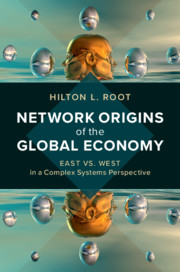Book contents
- Network Origins of the Global Economy
- Network Origins of the Global Economy
- Copyright page
- Dedication
- Contents
- Figures
- Tables
- Contributors
- Preface
- Overview
- Acknowledgments
- Part I Political Economy and Complex Systems
- Part II An Analysis of Historical Regimes
- 4 Network Assemblage of Regime Stability and Resilience in Europe and China
- 5 Network Formation and the Emergence of Law: From Feudalism to Small-World Connectivity
- 6 The Network Foundations of the Great Divergence
- Part III The Coming Instability
- References
- Index
6 - The Network Foundations of the Great Divergence
from Part II - An Analysis of Historical Regimes
Published online by Cambridge University Press: 17 March 2020
- Network Origins of the Global Economy
- Network Origins of the Global Economy
- Copyright page
- Dedication
- Contents
- Figures
- Tables
- Contributors
- Preface
- Overview
- Acknowledgments
- Part I Political Economy and Complex Systems
- Part II An Analysis of Historical Regimes
- 4 Network Assemblage of Regime Stability and Resilience in Europe and China
- 5 Network Formation and the Emergence of Law: From Feudalism to Small-World Connectivity
- 6 The Network Foundations of the Great Divergence
- Part III The Coming Instability
- References
- Index
Summary
"Theories of niche construction and near-decomposability, which correspond to competition and decentralization in economic parlance, illuminate how respective networks of authority served parochial purposes, with motivations related to specific challenges: in China, to rule a large territory, and in Europe, to enhance the competitive power of small states in a fragmented landscape. A shift toward outward expansion made European elites less parochial and resulted in an explosive wave of innovation. China’s centralized network enabled periods of unmatched stability and prosperity; but the merit-based bureaucracy stifled innovation, preventing the rise of a merchant class, an independent private sector, and outward expansion, all of which were associated with Europe’s industrialization. China’s inward gaze ensured the paramount political power of bureaucratic elites, resulting in systemic corruption that grew extensively over time, impoverishing the peasantry and causing rebellions, chaos, and conflict – a process that repeated itself throughout China’s history.
Keywords
- Type
- Chapter
- Information
- Network Origins of the Global EconomyEast vs. West in a Complex Systems Perspective, pp. 148 - 178Publisher: Cambridge University PressPrint publication year: 2020

